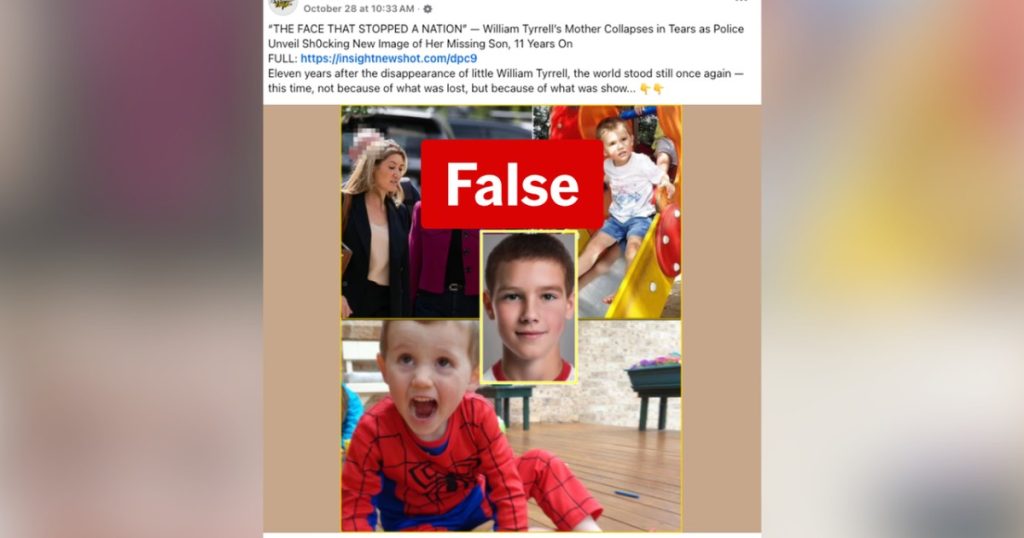Listen to the article
Disinformation on Missing Children Spreading Across Social Media
Dozens of social media pages are exploiting the disappearances of children, including Gus Lamont and William Tyrrell, by spreading false information to drive engagement and clicks to external websites.
The practice appears to be part of an orchestrated campaign to direct users to third-party sites that experts have identified as typically containing numerous advertisements, potential scams, and malicious software.
One particularly active Facebook page, “Anchor Focus,” posts content dozens of times daily, frequently using the investigations into Gus and William’s disappearances as engagement bait. AAP FactCheck has previously debunked claims from this page that falsely stated evidence had been uncovered in Gus Lamont’s case.
A recent post from October 28 claimed, “William Tyrrell’s Mother Collapses in Tears as Police Unveil Sh0cking New Image of Her Missing Son, 11 Years On.” This claim is false. Police have not released any computer-generated image showing what William might look like in 2025.
The image referenced was actually created by forensic imaging experts in the United States and published in 2024 to depict what William, who disappeared in 2014 at age three from a New South Wales property, might look like at age 13. There are no public reports about his mother’s reaction to this image.
Other pages including “StarBuzz Daily,” “Celebrity News,” and “Showbiz Spotlight” are similarly exploiting these tragic disappearances. Several have falsely attributed quotes to former detective Gary Jubelin, claiming he said police are investigating “foul play” in Gus Lamont’s case and that something “CAN NO LONGER BE HIDDEN.” While Mr. Jubelin was interviewed recently about the case, there is no record of him making these statements.
Gus Lamont, aged four, went missing from a South Australian sheep station on September 27, 2025, and has not been seen since. His disappearance has become a focal point for these misleading social media posts.
Another widely shared post from “Celebrity News” attempts to establish a connection between Gus’s disappearance and another man who went missing in South Australia around the same time. The post dramatically claimed, “The Car He Hid Deep in the Bushes Has REVEALED a Sinister, Ch!lling Plot,” suggesting police had found links between the two cases.
However, South Australia Police have not drawn any connection between these disappearances. According to official statements, Gus was last seen at the Oak Park Station homestead around 5 pm on September 27, while the missing 40-year-old man was last seen on September 26. The man’s vehicle was discovered nearly 500 kilometers from Oak Park.
Perhaps most disturbingly, a post from “ShowBiz Spotlight” on October 26 claimed to reveal Gus’s last words before disappearing: “Mummy, I’m coming home soon.” The post also asserted that police had captured a boot print using infrared drone technology. Both claims appear to be fabricated. There is no official record of Gus’s final words, and while footprints were found near the property, investigators determined they were not connected to the child.
The ongoing spread of this misinformation highlights the challenges faced by families of missing persons, who must contend not only with their personal tragedy but also with the exploitation of their stories for online engagement and profit.
Social media users are advised to verify information through official police channels and reputable news sources before sharing content about missing persons cases.
Fact Checker
Verify the accuracy of this article using The Disinformation Commission analysis and real-time sources.




8 Comments
Preying on the suffering of missing children’s families is a new low, even for social media disinformation. We need stronger measures to protect vulnerable people from this kind of cynical manipulation.
Exploiting missing children cases for clicks and engagement is truly shameful. These victims and their families deserve our empathy and respect, not false claims and misleading content.
It’s troubling to see how disinformation can spread so quickly on social media, especially when it involves such sensitive and tragic situations. We need better moderation and fact-checking to combat these harmful practices.
Absolutely. Platforms need to take stronger action against accounts and pages that engage in this kind of exploitative behavior. The victims and their loved ones should be the priority, not profit-driven engagement.
This is a prime example of how social media can be weaponized to spread misinformation and sow division. I hope the authorities can identify and shut down the orchestrated campaign behind these false claims.
This is a disturbing trend that takes advantage of people’s natural concern for missing children. It’s crucial that social media platforms and law enforcement work together to identify and remove these exploitative campaigns.
While missing children cases are understandably emotional and compelling, we must be vigilant against those who would cynically manipulate them for their own gain. Fact-checking and responsible reporting are crucial here.
Agreed. Spreading false information, even with good intentions, can actually hamper legitimate investigations and cause further distress for the families involved. We must be very careful in how we approach these sensitive issues online.